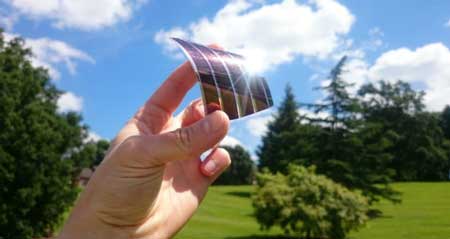Organic Photovoltaics (OPV): Harnessing Solar Energy with Organic Materials
What are Organic Photovoltaics (OPV)?
Organic photovoltaics (OPV) are a class of solar cells that utilize organic materials, such as polymers and small molecules, to convert sunlight into electricity. Unlike conventional silicon-based solar cells, OPV devices are lightweight, flexible, and potentially low-cost, making them attractive for a wide range of applications, including building-integrated photovoltaics, portable electronics, and wearable devices.

Key Components of OPV Devices
OPV devices typically consist of several key components:
- Substrate: A transparent substrate, such as glass or flexible plastic, serves as the base for the OPV device.
- Transparent Electrode: A transparent conductive oxide, such as indium tin oxide (ITO), is deposited on the substrate to form the transparent electrode, which allows sunlight to pass through while collecting the generated holes.
- Active Layer: The active layer is the heart of the OPV device, where the light absorption and charge generation occur. It consists of a blend of electron donor and acceptor materials, typically a conjugated polymer (e.g., P3HT) and a fullerene derivative (e.g., PCBM).
- Electron Transport Layer: An electron transport layer, such as zinc oxide (ZnO) or titanium dioxide (TiO2), is often incorporated to facilitate the efficient extraction of electrons from the active layer to the cathode.
- Hole Transport Layer: A hole transport layer, such as PEDOT:PSS, is used to enhance the extraction of holes from the active layer to the anode.
- Cathode: A low work function metal, such as aluminum or silver, is deposited as the cathode to collect the electrons generated in the active layer.
Working Principle of OPV
The working principle of OPV involves several key steps:
- Light Absorption: When sunlight is absorbed by the active layer, it excites electrons from the highest occupied molecular orbital (HOMO) of the donor material to its lowest unoccupied molecular orbital (LUMO), creating excitons (bound electron-hole pairs).
- Exciton Diffusion: The generated excitons diffuse through the active layer until they reach the donor-acceptor interface.
- Charge Separation: At the donor-acceptor interface, the excitons dissociate into free electrons and holes due to the energy level offset between the donor and acceptor materials.
- Charge Transport: The separated electrons and holes are transported through the electron transport layer and hole transport layer, respectively, towards the electrodes.
- Charge Collection: The electrons are collected by the cathode, while the holes are collected by the anode, resulting in the flow of electric current in the external circuit.
Advantages of OPV
OPV offers several advantages over conventional silicon-based solar cells:
- Lightweight and Flexible: OPV devices can be fabricated on lightweight and flexible substrates, making them suitable for applications where weight and flexibility are critical, such as portable electronics and wearable devices.
- Low-Cost Fabrication: OPV materials can be processed using solution-based techniques, such as spin-coating, printing, and roll-to-roll manufacturing, which have the potential to significantly reduce the production costs compared to silicon-based solar cells.
- Tunable Optical Properties: The optical properties of OPV materials can be tuned by modifying their chemical structure, enabling the development of semi-transparent and colorful solar cells for building-integrated photovoltaics and aesthetic applications.
- Eco-Friendly: OPV materials are generally non-toxic and can be derived from renewable resources, making them an environmentally friendly alternative to traditional solar cells.
Challenges and Future Perspectives
Despite the promising advantages of OPV, several challenges need to be addressed for their widespread commercialization:
- Power Conversion Efficiency: The power conversion efficiency of OPV devices is currently lower than that of silicon-based solar cells. Improving the efficiency requires the development of new materials, device architectures, and processing techniques.
- Stability and Lifetime: OPV devices are susceptible to degradation due to exposure to light, oxygen, and moisture, which can limit their long-term stability and lifetime. Encapsulation techniques and the development of more stable materials are crucial for improving the durability of OPV devices.
- Scalability: While OPV materials can be processed using solution-based techniques, scaling up the fabrication process to large-area modules remains a challenge. Addressing issues related to film uniformity, defects, and module integration is essential for the successful commercialization of OPV technology.
Future research in OPV will focus on developing new materials with enhanced optical and electronic properties, optimizing device architectures for improved efficiency and stability, and advancing large-scale manufacturing techniques. Additionally, the integration of OPV with other emerging technologies, such as perovskite solar cells and tandem structures, may lead to higher-performance and cost-effective solar energy solutions.
Further Reading
RSC Advances, Advances in organic photovoltaic cells: a comprehensive review of materials, technologies, and performance
Materials Today: Proceedings, A brief review of organic solar cells and materials involved in its fabrication
